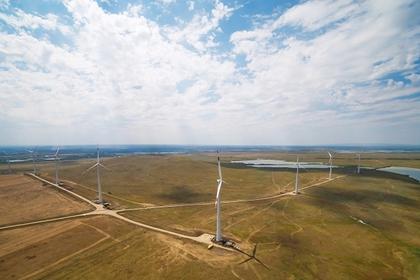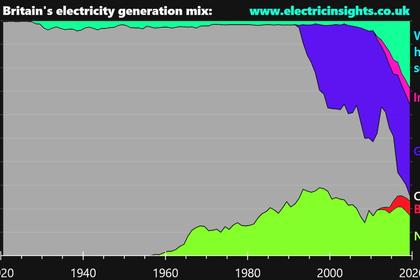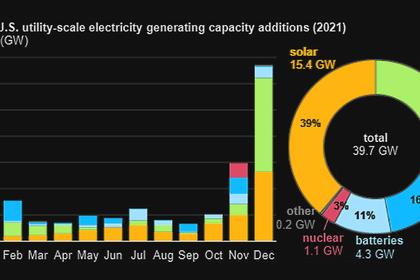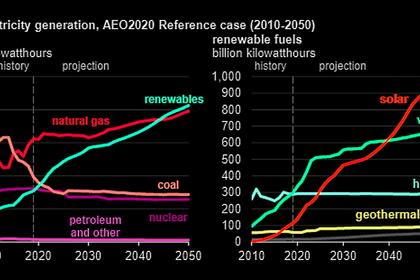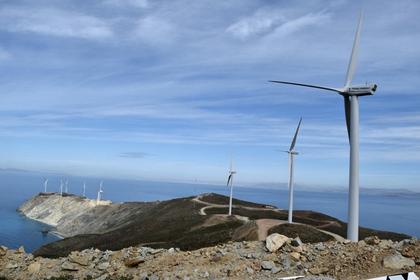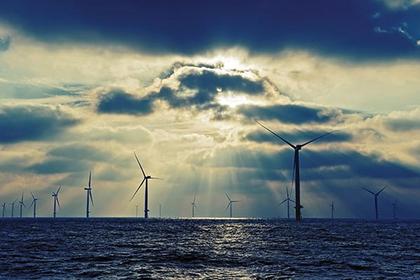
OECD RENEWABLE ELECTRICITY UP 12%
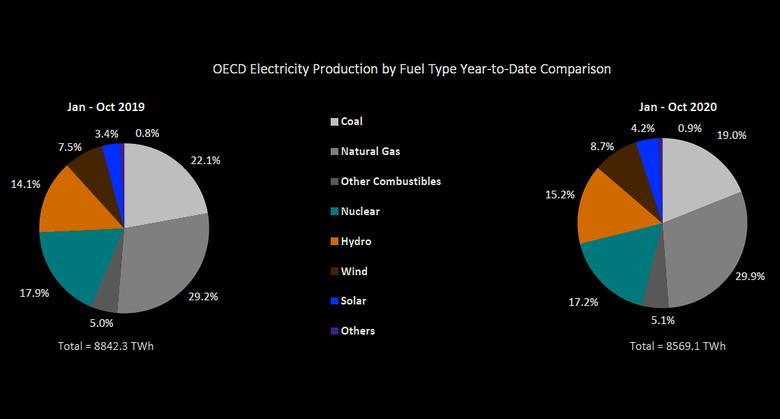
IEA - Jan 15, 2021 - MONTHLY OECD ELECTRICITY STATISTICS, October 2020
HIGHLIGHTS
OECD
In October 2020, total net electricity production in the OECD was 835.6 TWh, down by 1.1% compared to October 2019 and down by 0.5% compared to September 2020.
Renewable electricity production was 262.8 TWh, up by 12.4% compared to October 2019 and by 8.7% compared to September 2020. Renewables produced 31.4% of total electricity in October 2020 up from 29.0% in September 2020, mainly due to increased storm activity. This resulted in higher wind and hydroproductions. Wind output was 84.8 TWh, up by 16.7% compared to October 2019 and by 34.3% compared to September 2020. Hydroproduction was 119.4 TWh, up by 11.7% compared to October 2019 and by 5.3% compared to September 2020.
Non-renewable electricity production amounted to 68.6% of the total electricity output in October 2020, down by 6.3% compared to October 2019 and by 4.2% compared to September 2020. Nuclear production was 141.2 TWh in October 2020, 6.3% lower than in October 2019 and 4.7% higher than in September 2020. Conventional thermalproduction was responsible for 54.2% of the total electricity production in October 2020, or 453.1 TWh. Conventional thermal output was 6.0% lower than in October 2019 and 6.3% lower than in September 2020.
OECD Americas
In OECD Americas, total net production was 405.5 TWh, 1.7% lower than in October 2019 and 3.9% lower than in September 2020. The 2020 Atlantic hurricane season was the most active on record, with Hurricane Delta forming early in the month. As a result, renewable electricity production increased in October 2020 and was 110.7 TWh, 9.7% higher than in October 2019. This active hurricane season resulted in wetter than average conditions, hydroproduction was 59.6 TWh, 11.1% higher than in October 2019. Strong wind conditions drove wind electricity production up to 34.3 TWh, up by 25.5% compared to September 2020.
In Mexico, renewable production was 5.7 TWh, 46.7% higher than in October 2019 and 1.7% higher than in September 2020. Wind production was 1.7 TWh, up by 51.3% compared to October 2019 and by 38.4% compared to September 2020. In the first ten months of 2020, wind production was 15.6 TWh, up by 16.1% compared to the same period in 2019.
In the United States, wind production was 28.7 TWh, up by 4.5% compared to October 2019 and by 26.9% compared to September 2020. Wind production was the highest recorded for the month of October. Hydroproduction was 20.8 TWh, up by11.8% compared to October 2019 and down by 6.2% compared to September 2020. Although heavy rainfall was observed in the western part of the United States as a consequence of hurricane Delta, conditions were much drier than average in the western part of the country where most of the hydro capacity is installed, resulting in lower hydro power output in October 2020.
OECD Asia/Oceania
Net electricity production in OECD Asia/Oceania was 142.6 TWh, down by 0.4% compared to October 2019 and by 4.1% compared to September 2020. Non-renewable production was 114.6 TWh, down by 2.5% compared to October 2019 and by 3.9% compared to September 2020. This lower output was caused by lower conventional thermal production, which decreased by 7.3% compared to September 2020 and was 100.6 TWh.
In Korea, nuclear power production was 12.8 TWh, up by 27.1% compared to October 2019 and by 44.9% compared to September 2020. In October 2020, nuclear power plants produced 29.8% of the total electricity output. Nuclear production increased significantly after 9 reactors were restarted over the course of September and October after being shut down for maintenance.
OECD Europe
In OECD Europe, total production was 287.5 TWh, down by 0.6% compared to October 2019 and up by 6.9% compared to September 2020. Renewable production was 124.2 TWh, 15.8% higher than in October 2019 and 12.7% higher than in September 2020. Higher renewable output was driven by higher hydro and wind productions.The 2020-21 European storm season began in late September 2020 and two storms hit Europe in October 2020. As a result, wetter and windier than average conditions were observed all across Europe. Hydroproduction was 49.9 TWh, up by 17.2% compared to October 2019 and 11.1% compared to September 2020 and wind production was 47.2 TWh, up by 24.5% compared to October 2019 and by 45.9% compared to September 2020.
Storm Alex made landfall in the western part of France in early October, causing strong wind currents and heavy rainfall all over the country and for a next ended period of time. As a result, wind production was 4.3 TWh in October 2020, 24.1% higher than in October 2019 and 99.3% higher than in September 2020. Hydroproduction was 5.2 TWh, 33.3% higehr than in October 2019 and 49.9% higher than in September 2020. Overall, electricity production increased by 28.3% in October 2020 compared to September 2020. With this increase, production has returned to expected seasonally-adjusted levels after being historically low for six months following the onset of the Covid-19 pandemic.
Portugal was affected by Storm Barbara and as result, hydroproduction increased significantly due to heavy rainfall. Hydro output was 995.1 GWh, 81.6% higher than in October 2019 and 49.2% higher than in September 2020. Over the first ten months of 2020, hydroproduction increased by 64.9% compared to the same period in 2019, during which a severe drought was observed on the Iberian Peninsula.
Spain was also affected by Storms Alex and Barbara in October 2020. Wind production was 5.7 TWh, up by 51.4% compared to October 2019 and by 45.8% compared to September 2020, reaching a seasonal maximum. Hydroproduction was 2.1 TWh, up by 71.5% compared to October 2019 and 13.8% compared to September 2020. During the first ten months of 2020, hydro production increased by 46.1% compared to the same period last year, during which a long lasting drought was observed.
-----
Earlier:
